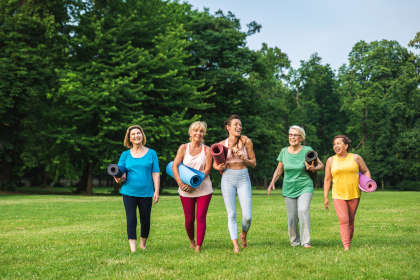Maintaining balance becomes increasingly important in our later years, but is often more challenging. Walking aids such as canes or walkers can offer valuable support, but there may be moments — like in small spaces such as bathrooms — where self-reliance is critical. Having the ability to move about freely brings both physical benefits and a sense of empowerment.
Pre-sorted Prescriptions | Home Delivery | Only Pay Your Copays
Stability and coordination are absolutely essential for older adults to facilitate everyday tasks such as dressing, walking, and other activities of daily living. This autonomy contributes to independence and an improved quality of life. A selection of balance exercises tailored for older adults can cultivate improved stability and coordination. This guide outlines five key exercises that can be practiced within the familiar comforts of home.
The Importance of Balance and Flexibility Exercises: Physical Benefits
As we age, certain changes happen naturally in our bodies. Muscle mass diminishes, and bone density reduces, both of which contribute to a decreased ability to maintain balance. However, age itself is not a barrier to getting better. Targeted exercises can counteract these changes, resulting in many benefits:
Enhanced Joint Flexibility and Mobility
Our joints may become stiff, limiting freedom of movement and making simple activities harder to perform. Balance and flexibility exercises improve joint function, enhancing the range of motion essential for day-to-day functions.
Reducing the Risk of Falls and Injuries
One of the main concerns in older adult health is the increased risk of falling. Regularly participating in balance exercises has been shown to reduce the risk of falls by up to 24% through improved joint flexibility, muscular strength, and coordination.
Strengthening the Core Body
The core is the body’s central hub, connecting multiple muscle groups that are used by the abdomen, back, and pelvis. Balance exercises strengthen the core, which enhances posture, body movements, and spinal support.
Improving Overall Physical and Mental Well-being
Any form of physical activity contributes to general health and can slow down the progression of chronic conditions such as heart disease, diabetes, and obesity. Regular exercise also offers mental health benefits, including stress reduction and improved mood.
Improving Bone Health
Some balance exercises include weight-bearing movements, which can strengthen bone density. This can be very helpful in reducing the risks of osteoporosis, or thinning of the bones.
Get Your Pills Pre-sorted and Delivered at No Extra Cost
5 Practical Balance Exercises
The following exercises offer several ways to improve balance by shifting weight from one side to the other, narrowing the base of support, and helping the muscles become strong enough to hold different positions for short periods of time. It is important when starting out to have a sturdy object nearby, such as a wall, chair, or counter space, to hold onto, to help keep one’s balance. Even trained dancers use a barre when they are practicing. One should only perform each exercise for as long, or as many times, as it feels safe to do so.

1. Single-Leg Balance
- Start in a standing position with the wall or a chair in front or to the side of the body, standing with feet shoulder-width apart.
- Rest one or both hands against the wall or hold on to the back of the chair.
- Lift one foot off the ground by moving it to the front, side, or back.
- Maintain this position for 15 – 30 seconds.
- Lower the foot, rest briefly, then switch to the other leg.
- As this becomes easier, try releasing the hands from the chair or wall.
Benefits: This exercise engages the core, enhances posture, and works on each side of the body.
2. Back Leg Raises
- Stand behind a chair, holding the top for support.
- Lift one leg straight back without bending the knee.
- Hold for 5 – 15 seconds before returning the leg to the ground.
- Perform this exercise 10 – 15 times on each leg.
Benefits: This exercise targets the lower back and buttock muscles that carry much of our body weight and keep the spine stable.
3. Marching in Place
- Stand upright and lift one knee toward the stomach, or as high as comfortably possible.
- Hold for 1 – 2 seconds.
- Lower the knee and repeat with the other leg.
- Complete this exercise 10 times with each leg.
- As this becomes easier, increase to 20 times on each side.
Benefits: This exercise improves muscle strength and core stability.
4. Sit and Stand (Chair Squats)
- Start out seated in the middle of a chair with armrests.
- Spread the legs about hip-width apart and put the feet flat on the floor.
- The arms should be extended out in front or crossed over the chest, if possible, while trying to rise out of the chair. They can be placed on the armrests if using the arms is needed to get up.
- Slowly exhale (do not hold your breath) and stand up.
- Inhale when fully standing, and slowly lower the body down as if sitting, but do not actually rest your weight on the seat if possible.
- Hold for 1 second, then return to standing.
- Complete this action five times.
- As this becomes easier, increase to 10 times.
Benefits: This functional strengthening exercise is like an action needed every day, enhancing leg strength and stability.
Your Prescriptions Sorted and Delivered
5. Calf Stretches
- Stand facing a wall with feet hip or shoulder width apart, placing your palms flat against it at about eye level.
- Place one leg 1 or 2 feet farther back than the other leg.
- Place both heels on the ground.
- Slightly bend your front knee and straighten the back leg until you feel a stretch in the back calf muscles, holding the stretch for 15 – 30 seconds.
- Perform 2 – 4 times for each leg.
- As this becomes easier, try releasing the hands from the wall.
- Benefits: This stretching exercise improves back leg flexibility, improves forward leg strength, and increases stability.
Including balance exercises daily improves physical conditioning and overall quality of life. These exercises are designed to be effective and feasible, requiring just a bit of time and effort. Regular practice has the potential to promote your independence, health, and well-being.


